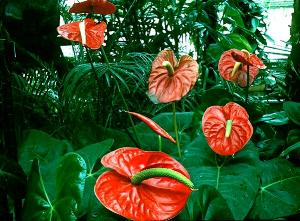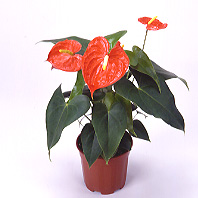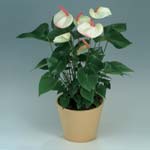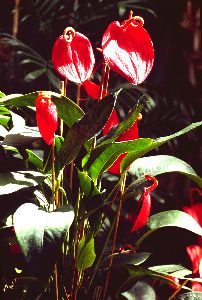|
Plants for your home
(By Mary Efanti)
Ánthurium
Description - Origin
 The photograph has definitely impressed you and you probably want to learn more about the
anthurium, this impressive indoor plant. The photograph has definitely impressed you and you probably want to learn more about the
anthurium, this impressive indoor plant.
This plant is native to Hawaii and belongs into the same family of plants
(araceae) as the spathifyllum, dieffenbachia, philodendron, and
aglaonema. Just looking at them you will notice that the similarity of their foliage is
obvious. As in the other members of this family, the anthurium is poisonous if
ingested, so keep your plants away from small children or pets.
Its flowers have the shape of a heart, are usually red in color and very
long-lasting. The intervention of modern science has turned flowers into
pink, white, green, orange or even bi-colors. Anthuriums are rich
bloomers, flowering throughout the year and in some varieties the flowers have a very discreet and light
fragrance.
Anthuriums were originally greenhouse plants, cultivated with the only purpose of trading cut
flowers. As an indoor plant, the anthurium was introduced as late as the 70s. Its flowers may look wonderful in your vase but let's cultivate anthuriums in a pot so that we can always enjoy its wonderful flowers inside our
homes. Moreover, even when not blooming, the anthurium is still a beautiful foliage
plant.
Care
Anthuriums are indoor
plants. Even though they are not very hard to care for, they cannot stand any
neglect. If the conditions are suitable, they bloom throughout the year and live for many
years. Usually, blooming is richer in spring and summer but this is mainly because days are brighter and
longer.
In general, the average indoors temperature is suitable for anthuriums however you should avoid placing them at spots where there are drafts or temperatures
fluctuate, e.g. next to outside doors, radiators or other heat producing appliances such as the
TV.
High temperatures may scorch the leaves, fade flower color and reduce their
longevity. On the contrary, low temperatures will delay the plant's development and the bottom leaves will turn yellow and fall
off. In case of frost, you can wave your anthurium good-bye as it cannot withstand freezing temperatures even for short
periods.
Mist its leaves often in order to provide humidity and clean both leaves and flowers with a wet sponge in order to keep it clean and to remove any insects that have attacked the
plant. Use a humidifier or a tray of wet pebbles in order to provide the humidity
needed.
Anthuriums can be
cultivated, always indoors, in pots, as independent plants or in
groups. Repot only when the roots take over all the space of the
pot, using a new pot that is only one size larger than the old one. Make sure to press hard on the soil while repotting to ensure that the plant does not need stakes or any other
support. After repotting don't get alarmed if you see some leaves here and there turning yellow and falling off because the plant is only getting accustomed to the new conditions and it will soon
recover.
 As the plant
develops, its foliage and flowers turn quite heavy and need a stable root system to hold their
weight. Every time you repot, add some pebbles or plastic pellets in the
soil, in order to provide good drainage and because pebbles help roots to get a good
grip. As the plant
develops, its foliage and flowers turn quite heavy and need a stable root system to hold their
weight. Every time you repot, add some pebbles or plastic pellets in the
soil, in order to provide good drainage and because pebbles help roots to get a good
grip.
The soil in the pot should be
light, containing peat moss and perlite and should have excellent
drainage. Water only when the soil feels dry to the touch, using plenty of water and remove any stagnant water from the dish of the pot
(this will help avoid the annoying gnats as well).
The best way to water anthuriums is to place the whole pot into a bucket or dish with water and let it absorb as much water as it
needs. You will know it is time to take it out when the babbles
stop. Let it sit until all excess water drains and return it to its original
location.
 Although anthuriums are draught tolerant plants do not let them stay dry for long because their development will be reduced
enormously. On the other hand, if you over water, its leaves will turn yellow and its roots will
rot. Always cut off yellowing or dry leaves and spent flowers in order to help production of new
buds. Although anthuriums are draught tolerant plants do not let them stay dry for long because their development will be reduced
enormously. On the other hand, if you over water, its leaves will turn yellow and its roots will
rot. Always cut off yellowing or dry leaves and spent flowers in order to help production of new
buds.
As a rule, anthuriums (as all indoor plants) need to be at the spot where they can get as much light as
possible. Always provide filtered light and not direct sun. Anthuriums will survive lower light situations but their blooming and development will be
compromised.
Fertilizing is not necessary, but if you decide your plant could use a little
help, use a slow release fertilizer in tablets or pellets and use half the dosage mentioned on the instruction
tag. Remember that pellets should not come in direct contact with the trunk or stems of the
plant. Also, make sure to select a fertilizer that enhances blooming and not foliage
development.
Anthuriums are generally resistant to disease but may eventually be attacked by
aphids, scale or thrips who constitute the most serious problem for
anthuriums.
Usually you can notice insects on new growth or flower buds. Take immediate action and either use an insecticide you can buy at any nursery or use the
non-toxic mixtures we have covered in many other care sheets. Whatever you decide to
use, don't forget to spray the undersides of leaves and flowers which are favorite places for
insects.
Especially for thrips, you should not waste time as thrips may destroy all the flowers since they attack the buds before they open
up. In case a bud is attacked, when it opens up you will notice white lines or cuts on the surface of the flower which could also be slightly
deformed. If you have chrysanthemums (mums) or orchids nearby be very alert because these plants are very prone to
thirps. Any nursery can provide insecticides for thrips but you will need to spray more than once and always follow the instructions on the
label.
Taking into account insects and disease in general, still the main
(and most common) reason indoor plants die is root-rot because of over
watering.
 Anthuriums may be propagated through seed but this is a long hard
procedure. Seeds are created without any intervention as the plant is
self-pollinating. Long after pollination you will notice one or two yellowish round
fruits. Cut them off and press lightly between your fingers. You will see 1-2 green seeds coming out of the
pulp. Plant them in a shallow dish, place it in a shaded spot and
wait. Four to six months afterwards, the new plants are ready to be repotted in larger
pots. Be patient as you will have to wait for at least 18 months from planting till blooming while this time varies widely and may reach 3 whole years to get an anthurium grown from seed to
flower. Anthuriums may be propagated through seed but this is a long hard
procedure. Seeds are created without any intervention as the plant is
self-pollinating. Long after pollination you will notice one or two yellowish round
fruits. Cut them off and press lightly between your fingers. You will see 1-2 green seeds coming out of the
pulp. Plant them in a shallow dish, place it in a shaded spot and
wait. Four to six months afterwards, the new plants are ready to be repotted in larger
pots. Be patient as you will have to wait for at least 18 months from planting till blooming while this time varies widely and may reach 3 whole years to get an anthurium grown from seed to
flower.
In some lucky
cases, the plant may be propagated from cuttings placed in water until they develop
roots. With this method chances of success are very limited.
You can buy anthuriums in any organized nursery or florist. They are usually more expensive than other popular houseplants but anthuriums are surely worth your money and your efforts as they are definitely the most impressive and perhaps one of the most beautiful indoor
plants.
Mary Efanti
[email protected]
|
